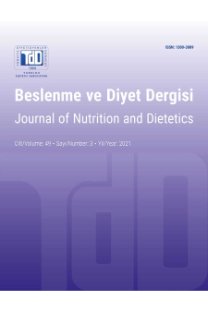Adölesanlarda Duygusal Yeme, Kontrolsüz Yeme ve Bilişsel Yeme Kısıtlaması Davranışları ile Vücut Bileşimi Arasındaki İlişkinin Değerlendirilmesi
An Evaluation of the Relationship across Emotional Eating, Uncontrolled Eating, Cognitive Restraint Behaviours and Body Compositions in Adolescents
___
- 1.Ramachandran VS. Encyclopedia of human behavior. 2nd ed.Boston, MA: Elsevier; 2012.
- 2.Brown BB, Prinstein MJ. Encyclopedia of adolescence. Amsterdam ; Boston: Elsevier/Academic Press; 2011.
- 3.Vyncke KE, Libuda L, De Vriendt T, Moreno LA, Van Winckel M, Manios Y, et al. Dietary fatty acid intake, its food sources and determinants in European adolescents: the HELENA (Healthy Lifestyle in Europe by Nutrition in Adolescence) Study. Br J Nutr 2012;108(12):2261- 2273.
- 4.Diethelm K, Jankovic N, Moreno LA, Huybrechts I, De Henauw S, De Vriendt T, et al. Food intake of European adolescents in the light of different food-based dietary guidelines: results of the HELENA (Healthy Lifestyle in Europe by Nutrition in Adolescence) Study. Public Health Nutr 2012;15(3):386-398.
- 5.Biro FM,Wien M. Childhood obesity and adult morbidities. Am J Clin Nutr 2010;91(5):1499S-1505S. Field AE, Cook NR,Gillman MW. Weight status in childhood as a predictor of becoming overweight or hypertensive in early adulthood. Obes Res 2005;13(1):163-169.
- 6.Ogden CL, Carroll MD, Kit BK, Flegal KM. Prevalence of obesity and trends in body mass index among US children and adolescents, 1999-2010. JAMA 2012;307(5):483-490.
- 7.Swanson SA, Crow SJ, Le Grange D, Merikangas KR. Prevalence and correlates of eating disorders in adolescents. Results from the national comorbidity survey replication adolescent suplement. Arch Gen Psychiatry 2011;68(7):714-23.
- 8.Bibiloni Mdel M, Pich J, Pons A,Tur JA. Body image and eating patterns among adolescents. BMC Public Health 2013;13:1104.
- 9.Ozier AD, Henry BW, American Dietetic, A. Position of the American Dietetic Association: nutrition intervention in the treatment of eating disorders. J Am Diet Assoc 2011;111(8):1236-1241.
- 11.Levine MP, Piran N. The role of body image in the prevention of eating disorders. Body Image 2004;1(1):57-70.
- 12.Angle S, Engblom J, Eriksson T, Kautiainen S, Saha MT, Lindfors P, et al. Three factor eating questionnaire-R18 as a measure of cognitive restraint, uncontrolled eating and emotional eating in a sample of young Finnish females. Int J Behav Nutr Phys Act 2009;6:41.
- 13.Megalakaki O, Mouveaux M, Hubin-Gayte M,Wypych L. Body image and cognitive restraint are risk factors for obesity in French adolescents. Eat Weight Disord 2013;18(3):289-295.
- 14.Keskitalo K, Tuorila H, Spector TD, Cherkas, LF, Knaapila A, Kaprio J, et al. The Three-Factor Eating Questionnaire, body mass index, and responses to sweet and salty fatty foods: a twin study of genetic and environmental associations. Am J Clin Nutr 2008;88(2):263-271.
- 15.de Lauzon-Guillain B, Romon M, Musher-Eizenman D, Heude B, Basdevant A, Charles MA, et al. Cognitive restraint, uncontrolled eating and emotional eating: correlations between parent and adolescent. Matern Child Nutr 2009;5(2):171-178.
- 16.Büyüktuncer Z, Büyükkaragöz AH, Balcı TN. Validation of the three eating questionnaire revised -18 in a sample of Turkish university students. (unpublished)
- 17.Pekcan G. Beslenme durumunun saptanması. Editörler: Baysal A, Aksoy M, Besler HT, Bozkurt N, Keçecioğlu S, Mercanlıgil SM, ve ark. Diyet El Kitabı. 7. Baskı. Hatiboğlu Yayınları; 2013. s. 106.
- 18.de Lauzon-Guillain B, Basdevant A, Romon M, Karlsson J, Borys JM, Charles MA. Is restrained eating a risk factor for weight gain in a general population? Am J Clin Nutr 2006;83(1):132-138.
- 19.Gallant AR, Tremblay A, Perusse L, Bouchard C, Despres JP, Drapeau V. The Three-Factor Eating Questionnaire and BMI in adolescents: results from the Quebec family study. Br J Nutr 2010;104(7):1074- 1079.
- 20.Konttinen H, Silventoinen K, Sarlio-Lahteenkorva S, Mannisto S, Haukkala A. Emotional eating and physical activity self-efficacy as pathways in the association between depressive symptoms and adiposity indicators. Am J Clin Nutr 2010;92(5):1031-1039.
- 21.de Lauzon-Guillain B, Romon M, Musher-Eizenman D, Heude B, Basdevant A, Charles MA. Cognitive restraint, uncontrolled eating and emotional eating: correlations between parent and adolescent. Matern Child Nutr 2009;5(2):171-178.
- ISSN: 1300-3089
- Yayın Aralığı: 3
- Başlangıç: 1972
- Yayıncı: Türkiye Diyestisyenler Derneği
KÜBRA IŞGIN, Ceyda Tuğba PEKMEZ, CANSU ÇETİN, Arzu KABASAKAL, Zehra DEMİREL BÜYÜKTUNCER, Tanju H. BESLER
Obezite ile Barsak Mikrobiyotası İlişkisi ve Obezitede Prebiyotikler ve Probiyotiklerin Kullanımı
ZEYNEP CAFEROĞLU, Hülya ÖZEL GÖKMEN, Fırat HAMİDİ, Gözde ERTÜRK
Nörolojik Yutma Bozukluğu Olan Çocukların Besin Tüketim Durumlarının Değerlendirilmesi
Nurcan BAĞLAM, Emine YILDIZ, ELİF ACAR ARSLAN, Güzide TURANLI
Türkiye'nin Farklı Bölgelerinden Alınan Baharat Örneklerinde Fenilalanin Miktarlarının Belirlenmesi
Diyabetik Nefropatide Tıbbi Beslenme Tedavisi
Nesil Gören ATALAY, GÜL KIZILTAN
Genç Yetişkinlerin Beslenme Durumunun Sağlıklı Yeme İndeksi-2005 İle Değerlendirilmesi
RÜVEYDA ESRA ERÇİM, Gülden PEKCAN
Neşe Yıldız KAYA, Selim KURTOĞLU
Besin ve Besin Ögesi ile İlaç Etkileşimleri
Aygin BAYRAKTAR EKİNCİOĞLU, Kutay DEMİRKAN
